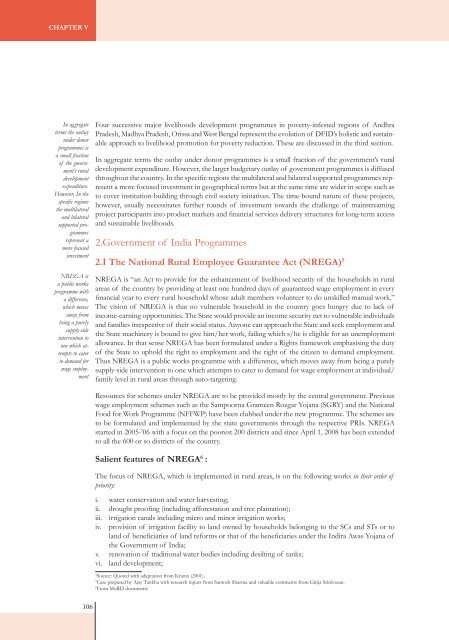SOIL Report 2008 - ACCESS Development Services
SOIL Report 2008 - ACCESS Development Services
SOIL Report 2008 - ACCESS Development Services
You also want an ePaper? Increase the reach of your titles
YUMPU automatically turns print PDFs into web optimized ePapers that Google loves.
Chapter VIn aggregateterms the outlayunder donorprogrammes isa small fractionof the government’sruraldevelopmentexpenditure.However, In thespecific regionsthe multilateraland bilateralsupported programmesrepresent amore focusedinvestmentNREGA isa public worksprogramme witha difference,which movesaway frombeing a purelysupply-sideintervention toone which attemptsto caterto demand forwage employmentFour successive major livelihoods development programmes in poverty-infested regions of AndhraPradesh, Madhya Pradesh, Orissa and West Bengal represent the evolution of DFID’s holistic and sustainableapproach to livelihood promotion for poverty reduction. These are discussed in the third section.In aggregate terms the outlay under donor programmes is a small fraction of the government’s ruraldevelopment expenditure. However, the larger budgetary outlay of government programmes is diffusedthroughout the country. In the specific regions the multilateral and bilateral supported programmes representa more focused investment in geographical terms but at the same time are wider in scope such asto cover institution-building through civil society initiatives. The time-bound nature of these projects,however, usually necessitates further rounds of investment towards the challenge of mainstreamingproject participants into product markets and financial services delivery structures for long-term accessand sustainable livelihoods.2.Government of India Programmes2.I The National Rural Employee Guarantee Act (NREGA) 5NREGA is “an Act to provide for the enhancement of livelihood security of the households in ruralareas of the country by providing at least one hundred days of guaranteed wage employment in everyfinancial year to every rural household whose adult members volunteer to do unskilled manual work.”The vision of NREGA is that no vulnerable household in the country goes hungry due to lack ofincome-earning opportunities. The State would provide an income security net to vulnerable individualsand families irrespective of their social status. Anyone can approach the State and seek employment andthe State machinery is bound to give him/her work, failing which s/he is eligible for an unemploymentallowance. In that sense NREGA has been formulated under a Rights framework emphasising the dutyof the State to uphold the right to employment and the right of the citizen to demand employment.Thus NREGA is a public works programme with a difference, which moves away from being a purelysupply-side intervention to one which attempts to cater to demand for wage employment at individual/family level in rural areas through auto-targeting.Resources for schemes under NREGA are to be provided mostly by the central government. Previouswage employment schemes such as the Sampoorna Grameen Rozgar Yojana (SGRY) and the NationalFood for Work Programme (NFFWP) have been clubbed under the new programme. The schemes areto be formulated and implemented by the state governments through the respective PRIs. NREGAstarted in 2005-’06 with a focus on the poorest 200 districts and since April 1, <strong>2008</strong> has been extendedto all the 600 or so districts of the country.Salient features of NREGA 6 :The focus of NREGA, which is implemented in rural areas, is on the following works in their order ofpriority:i. water conservation and water harvesting;ii. drought proofing (including afforestation and tree plantation);iii. irrigation canals including micro and minor irrigation works;iv. provision of irrigation facility to land owned by households belonging to the SCs and STs or toland of beneficiaries of land reforms or that of the beneficiaries under the Indira Awas Yojana ofthe Government of India;v. renovation of traditional water bodies including desilting of tanks;vi. land development;4Source: Quoted with adaptation from Krantz (2001).5Case prepared by Ajay Tankha with research inputs from Santosh Sharma and valuable comments from Girija Srinivasan.6From MoRD documents106














